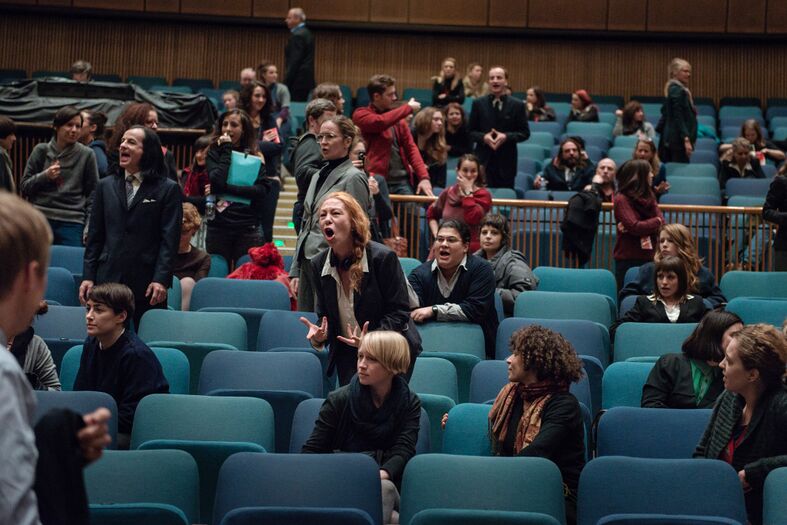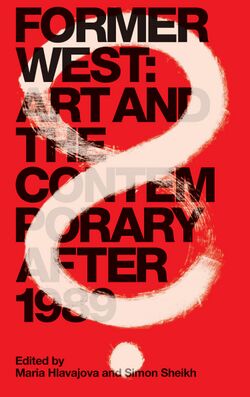Former West
Jump to navigation
Jump to search
If the “former East” emerged in the aftermath of the Cold War in 1989, its western geo-political counterpart—blinded by the (seemingly default) victory of neoliberal capitalism—has widely failed to recognize the impact of these massive changes upon itself. The so-called West has continued to think and act, symbolically and realistically, as “first” among what were supposed to have become equal if heterogeneous provinces of one world. One wonders precisely why then, when there is a “former East,” there is no “former West”? [1]
- Former West, 2008-2016. "A transnational research, education, publishing, and exhibition project in the field of contemporary art and theory. The project grapples with the repercussions of the political, cultural, and economic events of 1989 for the contemporary condition. It does so in the search for ways of formerizing the persistently hegemonic conjuncture that is “the West”; to be able instead to simply refer to “the west,” and with it, suggest the possibility of producing new constellations, another world, other worldings." Initiated by Maria Hlavajova (BAK), Charles Esche (Van Abbemuseum) and Katrin Rhomberg. Chronicle. Publication. Editorial meetings. Congresses. . Exhibitions. Seminars. Library. Interviews.
VIDEO
- 1st FORMER WEST Congress, Ottone, Utrecht, 5–7 Nov 2009. Program. Text. Photo. .
VIDEO
- 2nd FORMER WEST Research Congress: On Horizons: Art and Political Imagination, Istanbul Technical University, 4–6 Nov 2010. Program. .
VIDEO
- 3rd FORMER WEST Research Congress, Part One: Beyond What Was Contemporary Art, Academy of Fine Arts Vienna and Secession, Vienna, 19–20 Apr 2012. Program. .
VIDEO
- 3rd FORMER WEST Research Congress, Part Two: What on earth do they mean when they say art?, Utrecht School of the Arts, Utrecht, 29 Sep 2012. Program. Photo. .
VIDEO
- FORMER WEST: Documents Constellations Prospects, research congress, Haus der Kulturen der Welt, Berlin, 18-24 Mar 2013. "Artworks, talks, discussions, rehearsals, and performances in various constellations of documents and prospects offer a multitude of encounters with the public for negotiating the way of the world from 1989 to today, and thinking beyond." Contributions. Photos. Program. Texts. Booklet. Announcement. [2]
- Former West: Art and the Contemporary After 1989, eds. Maria Hlavajova and Simon Sheikh, Utrecht: BAK basis actuele kunst, Dec 2016, 748 pp. TOC, Preface, Editors' Note, [3], TOC, [4], [5]. "The Cold War was a contest not between two ideological blocs but between two variants of Western modernity. It is this conceptual “Westcentrism” that a “formering” of the West seeks to undo. The contributions revisit contemporary debates through the lens of a “former West.” They rethink conceptions of time and space dominating the legacy of the 1989–1990 revolutions in the former East, and critique historical periodization of the contemporary. The contributors map the political economy and social relations of the contemporary, consider the implications of algorithmic cultures and the posthuman condition, and discuss notions of solidarity — the difficulty in constructing a new “we” despite migration, the refugee crisis, and the global class recomposition." Contributors: Nancy Adajania, Edit András, Athena Athanasiou, Zygmunt Bauman, Dave Beech, Brett Bloom, Rosi Braidotti, Susan Buck-Morss, Campus in Camps, Dipesh Chakrabarty, Chto Delat?/What is to be done?, Jodi Dean, Angela Dimitrakaki, Dilar Dirik, Marlene Dumas, Keller Easterling, Okwui Enwezor, Charles Esche, Silvia Federici, Mark Fisher, Federica Giardini and Anna Simone, Boris Groys, Gulf Labor Coalition, Stefano Harney, Sharon Hayes, Brian Holmes, Tung-Hui Hu, Wendy Hui Kyong Chun, Sami Khatib, Delaine Le Bas, Boaz Levin and Vera Tollmann, Isabell Lorey, Sven Lütticken, Ewa Majewska, Artemy Magun, Suhail Malik, Teresa Margolles, Achille Mbembe, Laura McLean, Cuauhtémoc Medina, Sandro Mezzadra, Walter D. Mignolo, Aernout Mik, Angela Mitropoulos, Rastko Močnik, Nástio Mosquito, Rabih Mroué, Pedro Neves Marques, Peter Osborne, Matteo Pasquinelli, Andrea Phillips, Nina Power, Vijay Prashad, Gerald Raunig, Irit Rogoff, Boaventura de Sousa Santos, Naoki Sakai, Rasha Salti, Francesco Salvini, Christoph Schlingensief, Georg Schöllhammer, Susan Schuppli, Andreas Siekmann, Jonas Staal, Hito Steyerl, Mladen Stilinović, Paulo Tavares, Trịnh T. Minh-Hà, Mona Vătămanu and Florin Tudor, Marina Vishmidt, Marion von Osten, McKenzie Wark, and Eyal Weizman. Publisher. Reviews: McQuillen (SEEJ), Mavrokordopoulou (Critique d’art). Commentary: Gronemeyer, Lerm Hayes.

